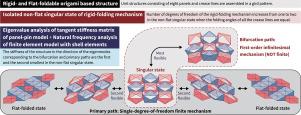刚性和可平折网格折纸结构在非平状态下具有分支机构
IF 3.8
3区 工程技术
Q1 MECHANICS
International Journal of Solids and Structures
Pub Date : 2025-07-11
DOI:10.1016/j.ijsolstr.2025.113520
引用次数: 0
摘要
本文采用面板-销模型和有限元模型研究了一种新型折纸平面可折叠结构的刚性折叠机理和弹性变形。整个提出的结构由在平面上以网格模式排列的单元结构组成。每个单元是由八个直角等腰三角形面板组成的环,由铰链连接。单个单元具有与著名的吉村管的单层相同的配置。利用两个网格方向上均有三个单元的面板-销模型对结构进行了无限小的机构分析,结果表明,该结构除在平面折叠状态外均表现为单一自由度机构,并且在刚性折叠机制分叉的单一孤立非平面奇异状态下表现为单一自由度机构。值得注意的是,非平坦奇异状态下的分岔机构只是一阶无穷小机构,不能导致有限机构。相比之下,通过对面板销模型的切向刚度矩阵的特征值分析,该分支机构在本征模态方向上的刚度最小。这在由壳单元和铰单元组成的有限元模型的固有频率分析中也得到证实。此外,可以简单地将均匀的面板厚度分配给所提出的结构,并且在任何面板厚度存在时,单自由度刚性折叠机制是一致的。这些独特的特性为创新的可展开、变形和弯曲主动结构提供了巨大的潜力。本文章由计算机程序翻译,如有差异,请以英文原文为准。

Rigid- and flat-foldable grid origami structure exhibiting bifurcation of mechanism in non-flat state
This study investigates a novel origami-based flat-foldable structure for its rigid-folding mechanism and elastic deformation using two models: a panel-pin model and a finite element model. The entire proposed structure consists of unit structures arranged in a grid pattern on a plane. Each unit is a ring of eight right-angled isosceles triangular panels connected by hinges. The single unit has the same configuration as a single layer of the well-known Yoshimura tube. The infinitesimal mechanism analysis of the structure using a panel-pin model with the three units in both grid directions reveals that the proposed structure exhibits a single-degree-of-freedom mechanism except in the flat-folded states and a single isolated non-flat singular state where the rigid-folding mechanism bifurcates. Notably, the bifurcated mechanism in the non-flat singular state is only a first-order infinitesimal mechanism and cannot lead to a finite mechanism. By contrast, the stiffness in the direction of this bifurcated mechanism, investigated through the eigenvalue analysis of the tangent stiffness matrix of the panel-pin model, is the smallest among those in the directions of eigenmodes. This is also confirmed in the natural frequency analysis of the finite element model consisting of shell and hinge elements. Furthermore, the uniform panel thickness can be simply assigned to the proposed structure, and the single-degree-of-freedom rigid-folding mechanism is consistent in the presence of any panel thickness. These distinctive properties offer promising potential for innovative deployable, morphing, and bending active structures.
求助全文
通过发布文献求助,成功后即可免费获取论文全文。
去求助
来源期刊
CiteScore
6.70
自引率
8.30%
发文量
405
审稿时长
70 days
期刊介绍:
The International Journal of Solids and Structures has as its objective the publication and dissemination of original research in Mechanics of Solids and Structures as a field of Applied Science and Engineering. It fosters thus the exchange of ideas among workers in different parts of the world and also among workers who emphasize different aspects of the foundations and applications of the field.
Standing as it does at the cross-roads of Materials Science, Life Sciences, Mathematics, Physics and Engineering Design, the Mechanics of Solids and Structures is experiencing considerable growth as a result of recent technological advances. The Journal, by providing an international medium of communication, is encouraging this growth and is encompassing all aspects of the field from the more classical problems of structural analysis to mechanics of solids continually interacting with other media and including fracture, flow, wave propagation, heat transfer, thermal effects in solids, optimum design methods, model analysis, structural topology and numerical techniques. Interest extends to both inorganic and organic solids and structures.

 求助内容:
求助内容: 应助结果提醒方式:
应助结果提醒方式:


